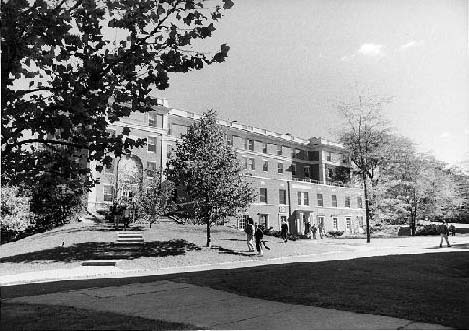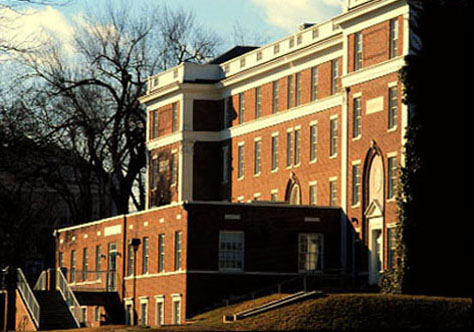History of the Public Affairs Center

A Brief History
The Andrus Center, commonly known as the Public Affairs Center (PAC), stands on a historic site that reflects Wesleyan’s long academic legacy. The original structure on the site, the Boarding Hall, was acquired by the University in 1833. Initially serving as a dining hall, it later became a dormitory and, in 1868, was renamed Observatory Hall after housing a newly installed telescope. The building remained in use until its demolition in 1927.
In 1928, Harriman Hall was constructed on the site, funded by Henry Ingraham Harriman (Class of 1895) in memory of his father, Daniel G. Harriman (Class of 1864). Henry Harriman, a Wesleyan trustee and NYU Law School graduate, had himself lived in Observatory Hall during his student years.
Harriman Hall was renamed the Public Affairs Center in 1954 when Professors Elmer Schattschneider and Kenneth Underwood launched it as a collaborative space for Wesleyan’s social science disciplines. The academic structure it supports today includes the departments of Economics, Government, History, Sociology, and the College of Social Studies.
The evolution of these disciplines at Wesleyan has been gradual. A combined department of History and Political Economy was founded in the 1880s. Economics became a separate department in 1890, while History and Government remained united until 1935. The interdisciplinary CSS was founded in 1959, and the Sociology department was added in 1967, completing the Center’s academic composition.
The PAC was named in honor of John E. Andrus, Class of 1862, whose family's Surdna Foundation provided funding for the building. A prominent philanthropist and public servant, Andrus served as mayor of Yonkers in 1903 and as a U.S. Congressman from 1904 to 1912. A generous supporter of Wesleyan, he contributed to the development of the library, athletic fields, and North College. He served as a trustee from 1889 until his death at age 93 in 1934.

The John E. Andrus Center for Public Affairs
The John E. Andrus Center for Public Affairs, established in 1954–55 under the leadership of the late Professor E.E. Schattschneider, served as both an academic hub and a physical space for the social sciences at Wesleyan University. The building housed the departments of Economics, Government, History, and Sociology, along with the interdisciplinary College of Social Studies (CSS).
The Center was overseen by a Director, supported by a Governing Board—composed of the chairs of the four departments and CSS—and Administrative Assistants. In addition to managing annual awards for an outstanding undergraduate and a junior faculty member, the Center hosted lectures, guest speakers, and interdisciplinary lunchtime seminars featuring Wesleyan faculty. It also sought external funding to support scholarly collaborations and innovative teaching in the social sciences.
A defining feature of the Center was its interdisciplinary design: faculty offices were deliberately mixed rather than grouped by department. This layout encouraged informal collaboration and conversation among scholars from different disciplines, whether during brown-bag lunches in the Elmer Schattschneider Lounge or over coffee in the shared kitchen—traditions that continued to foster the Center's founding vision.
